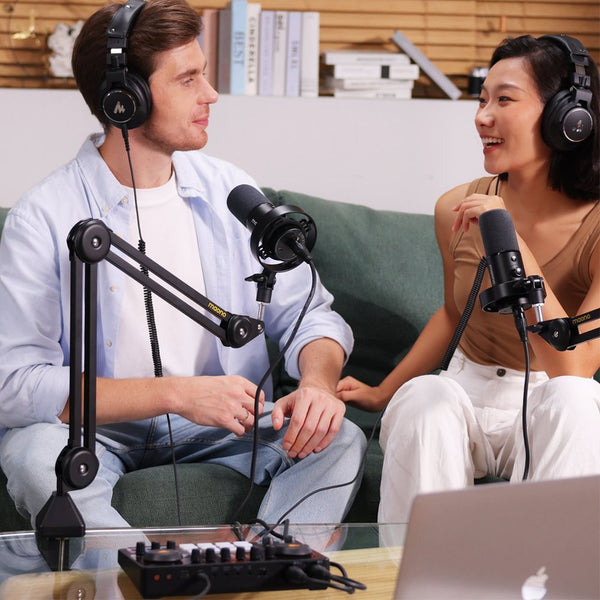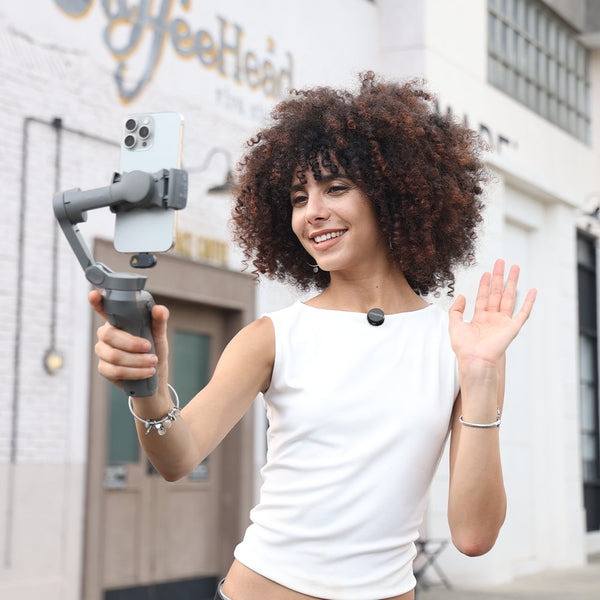Are you the type of person who loves to share, or do you prefer to listen? Whether you want to speak your mind, share your knowledge, or inspire others through a podcast, audio quality should be your top priority. After all, no one enjoys listening to a muffled voice—and you wouldn’t want to sound like that either. In this guide, we’ll explore some of the most common questions beginners have about podcasting and provide expert tips on choosing the right podcast microphone, proper placement techniques, and how to boost audience engagement.
Mental health podcasts have grown in popularity as people seek safe spaces for emotional support, psychological insight, and mental wellness strategies. Whether you're a licensed therapist, a life coach, or simply someone with a passion for helping others, launching a mental health podcast can be a powerful way to connect with and support listeners.
However, one often overlooked aspect of success is your voice—specifically, how it sounds on the mic. A calming voice tone, clean audio, and the right microphone setup can elevate your podcast from good to truly therapeutic. This article will guide you through how to achieve that warm, supportive audio experience and how to ethically and effectively create a trustworthy mental health podcast.
Mental health podcasts serve as a bridge for those seeking comfort, insight, or connection—especially when professional help may not be accessible. To deliver value and gain trust, your podcast must do more than offer great advice. It must sound safe, soothing, and professional. This begins with using the best microphone for a podcast, ensuring a clear USB podcast microphone setup, maintaining the right tone, and following ethical guidelines.
Voice Tone and Mic Technique for a Calming, Supportive Podcast
How do I get that warm, close-up sound that feels personal?
That warm, intimate sound you hear in top-rated mental health podcasts isn’t accidental. It's achieved through proper microphone technique and mic selection. Using a dynamic mic like the Maono PD300X or PD100U—both considered good USB microphones for podcast use—can help. These mics are built to capture your voice while rejecting background noise, delivering a smooth, rich tone that enhances closeness.
Get close to the microphone—around 6 to 10 inches—and speak gently but clearly. A conversational tone works best, allowing your listeners to feel like they’re being spoken to directly and compassionately.
What’s the ideal mic placement for a calming voice tone?
Mic placement matters just as much as your mic choice. Keep the microphone just below or to the side of your mouth to avoid plosives (harsh “P” or “B” sounds). Aim to speak past the mic, not directly into it. This setup avoids harsh audio peaks and keeps the tone gentle and balanced.
Using a boom arm or adjustable stand helps maintain consistent distance and position during recording sessions—crucial for smooth, uninterrupted delivery.
How do I reduce background noise and room echo at home?
To keep your audio clean and peaceful:
-
Record in a quiet room with soft surfaces like curtains, carpets, and cushions.
-
Avoid hard, reflective surfaces that bounce sound (bare walls, tiles).
-
Turn off noisy electronics like fans, AC units (if possible), and computers during recording.
-
Use noise-dampening panels or record inside a closet with clothes to absorb sound if you’re on a tight budget.
Microphones like the Maono PD300X, with dynamic capsules, are naturally less sensitive to room noise than condenser mics—making them great microphone USB podcast choices for home setups..
Do I need a pop filter or shock mount for smoother audio?
Yes. A pop filter eliminates sharp air sounds from speech, especially during “P” and “T” sounds. A shock mount isolates the mic from vibrations caused by desk bumps or shifting movement.
Using both accessories ensures that your voice remains smooth and uninterrupted, keeping the listening experience calm and enjoyable.
Improving Listener Engagement in Mental Health and Advice Podcasts
How do I sound trustworthy and soothing when giving advice?
Sounding trustworthy requires a blend of empathy, vocal tone, and pacing. Avoid fast, overly energetic speech. Instead, adopt a measured, thoughtful tone. Smile slightly as you speak—it naturally warms your voice. Use inclusive language like “we,” “together,” or “you’re not alone.”
Avoid jargon and speak in a way that feels accessible, as though you're guiding a friend rather than lecturing a client.
Should I script or speak freely when sharing mental health tips?
A hybrid approach works best. Write an outline or full script to organize your ideas, but allow room for spontaneity and natural expression. Rigid reading can sound robotic; free-form talking can sound messy. Practicing your script aloud before recording helps find the balance.
How long should each episode be for keeping the listener's attention?
For mental health podcasts, 20 to 40 minutes is ideal. It’s long enough to provide value without overwhelming listeners. If you're sharing complex advice, consider splitting topics across multiple episodes.
Legal & Ethical Considerations When Sharing Mental Health Content
Do I need a license to discuss mental health topics?
If you’re offering general advice or sharing personal experiences, you usually don’t need a license. However, diagnosing, treating, or providing therapy crosses into professional territory and requires credentials. Always stay within your qualifications.
Do I need a disclaimer if I’m not a licensed therapist?
Absolutely. A brief disclaimer at the beginning of each episode protects both you and your listeners. Something like:
"This podcast is for informational purposes only and is not a substitute for professional mental health advice."
Can I share listener-submitted stories or questions?
Yes, but only with consent. Avoid using real names or identifiable details unless explicitly permitted. You may also paraphrase submissions to protect anonymity.
What’s the ethical line between general advice and therapy?
Stick to educational or motivational content. Avoid telling listeners what to do in personal situations or giving clinical opinions. Instead, encourage seeking help from qualified professionals and offer general strategies or frameworks for self-reflection.
FAQs about Podcast Content:
How can I make my podcast feel like a safe space?
Use welcoming intros, empathetic language, and consistent tone. Be open about your intentions, limitations, and desire to help. Avoid judgmental phrases and create a sense of belonging with inclusive messaging.
What are the best ways to handle sensitive topics responsibly?
-
Research thoroughly
-
Include trigger warnings when needed
-
Invite experts to speak on delicate issues
-
Encourage professional help
-
Avoid oversimplifying complex mental health conditions
How do I edit my voice to sound smoother and more professional?
Use software like Audacity, Adobe Audition, or Descript to:
-
Normalize levels
-
Reduce background noise
-
Apply light compression
-
Use EQ to smoothen harsh tones
Avoid over-processing—your voice should still sound natural.
What platforms are best for advice- and psychology-related podcasts?
Top platforms include:
-
Spotify
-
Apple Podcasts
-
Google Podcasts
-
Anchor.fm (great for beginners)
-
Buzzsprout or Podbean for more analytics and monetization features
How do I grow an audience for a podcast focused on mental well-being?
-
Niche down (focus on specific audiences: parents, teens, grief, anxiety, etc.)
-
Collaborate with mental health advocates
-
Use social media for sharing clips and reels
-
Encourage listener feedback and questions
-
Use consistent posting schedules
How do I avoid sounding too clinical or robotic on the mic?
Speak like you're talking to a friend. Use natural inflection, avoid reading word-for-word, and allow for breath and pause. Smiling slightly while speaking, standing up, and using hand gestures can help your voice stay warm and animated.
FAQs About Using a Podcast Microphone:
Can I use a USB mic to start my advice podcast?
Yes! A microphone podcast USB is a great starting point, especially for solo podcasters. These mics plug directly into your computer and are compatible with most recording software.
The Maono PD100U is a good USB microphone for podcast beginners. It delivers rich voice quality and is ideal for calm and close-up speaking styles, perfect for those aiming for a gentle and professional podcast tone.
What’s the best microphone for recording a solo mental health podcast?
For best results, we recommend:
-
Maono PD300X
The Maono PD300X is a hybrid USB/XLR mic with 3-in-1 smart gain knob, a mute button and noise reduction features due to its cardioid pickup pattern. It delivers professional clarity with excellent noise rejection.
-
Maono PD100U
The Maono PD100U is a budget-friendly USB dynamic mic that’s compact, easy to use, and ideal for clear solo voice recordings in untreated rooms. It’s perfect for beginners especially if you’re looking to purchase a high-quality mic for less than $50.
Both options are designed to give your voice a warm, full-bodied tone—perfect for therapeutic podcasting.
Conclusion
Launching a calming mental health podcast takes more than just good intentions—it requires attention to sound quality, tone, ethics, and audience connection. With the right microphone USB podcast setup, such as the Maono PD300X or PD100U, and thoughtful voice delivery, you can create an audio environment that feels personal, soothing, and trustworthy.
By combining solid mic technique, ethical storytelling, and mindful content creation, your podcast can become a meaningful space for reflection, comfort, and emotional support—one voice at a time.



